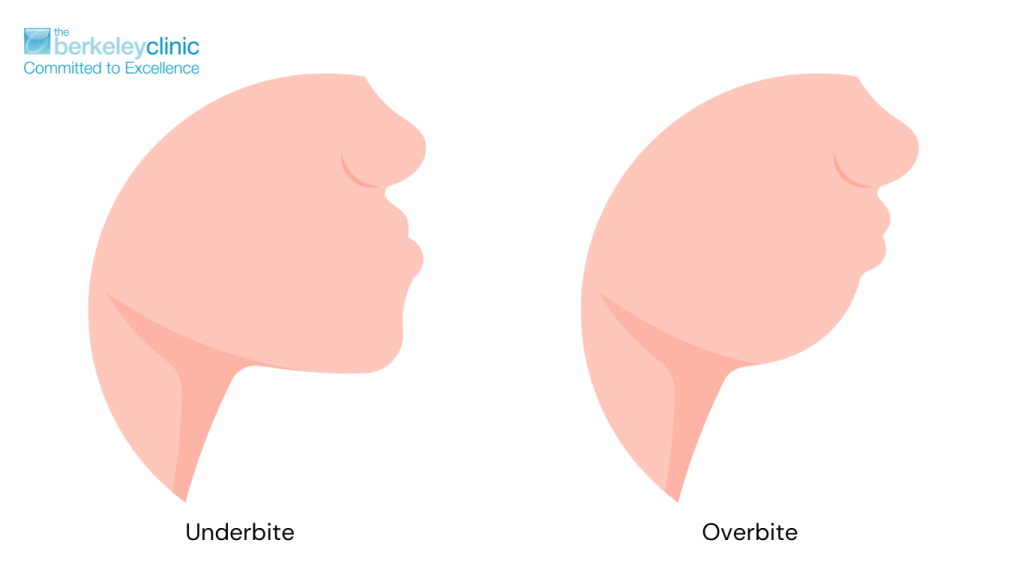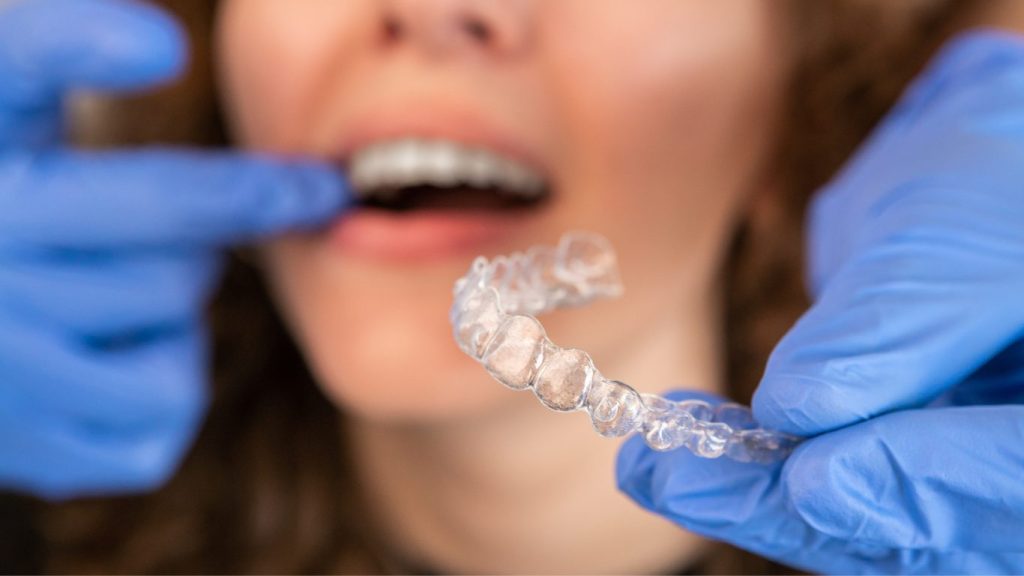You may have heard of Invisalign, a modern alternative to traditional braces that has been reshaping smiles since its FDA approval in 1998. But what exactly is Invisalign? It’s a series of custom-made, clear plastic trays designed to fit over your teeth. Unlike the traditional route of metal braces, Invisalign offers a less noticeable, more aesthetic solution for teeth straightening.
Before we explore how Invisalign addresses specific dental concerns, let’s talk about common alignment issues. A frequent reason people consider orthodontic treatment is to correct overbites – a condition where the upper teeth significantly overlap the lower teeth.
However, it’s not just about overbites. Misalignments like underbites, crossbites, and spacing issues are also part of the picture. These conditions can cause not only cosmetic concerns but also functional issues affecting your teeth, gums, or tongue.
But what’s Invisalign’s role in treating overbites? A 2017 study from the National Library of Medicine suggests that Invisalign is effective in correcting mild to moderate overbites.
Invisalign isn’t the only solution for aligning teeth, but it’s certainly a popular one. Its discreet nature makes it a favoured choice, especially among adults. Traditional metal braces, on the other hand, might be suggested for more complex alignment issues.
In this blog, we will focus on addressing overbite and underbite issues with Invisalign, providing insights and comparisons to traditional braces to assist you in making an informed decision for your orthodontic needs.
Understanding overbite and underbite

An overbite occurs when your upper front teeth extend further than your lower front teeth. It can be caused by genetics, jaw size discrepancies, or prolonged habits like thumb-sucking.
Conversely, an underbite is when your lower front teeth protrude beyond your upper front teeth. This misalignment can result from jaw misalignment, tooth misalignment, or a combination of both.
Potential health problems
Leaving these issues untreated might lead to various health concerns. Both overbites and underbites can contribute to problems like jaw pain, difficulty chewing, and even affect speech.
Additionally, they may cause uneven wear on your teeth, leading to dental complications.
It’s crucial to address these concerns early on to ensure a healthier and more comfortable smile.
How Invisalign works

Let’s break down how Invisalign works and its effectiveness in correcting overbite and underbite:
Invisalign operates on a simple principle. Custom-made clear plastic trays gently shift your teeth over time. These trays, called aligners, are worn for the majority of the day and are easily removable.
Comparison with traditional braces
Unlike traditional braces, Invisalign aligners are virtually invisible and don’t involve wires or brackets. They offer a more discreet and comfortable orthodontic experience for adults.
Here’s a comparison table highlighting the differences between Invisalign and traditional braces:
| Aspect | Invisalign | Traditional Braces |
| Appearance | Virtually invisible clear aligners | Noticeable metal brackets and wires |
| Comfort | Smooth plastic with no wires or brackets | Metal components may cause initial discomfort |
| Removability | Removable for eating and oral hygiene | Permanent fixtures until the end of treatment |
| Eating restrictions | None, aligners are removed while eating | Certain food restrictions to prevent damage |
| Cleaning | Easily removable for regular brushing and flossing | Requires additional care to clean around wires |
| Treatment duration | May vary but often comparable to traditional braces | Average treatment time ranges from 18-36 months |
| Adjustment visits | Limited visits, typically every 6-8 weeks | Frequent visits for adjustments and tightening |
| Effectiveness | Effective for mild to moderate orthodontic issues | Suitable for a wide range of orthodontic problems |
| Cost | Generally higher cost due to advanced technology | Typically more affordable option initially |
Invisalign for overbite correction
To correct an overbite, Invisalign works by strategically moving your teeth into the desired position. The timeline varies from person to person, and severe cases might still require traditional braces.
Invisalign for underbite correction
In the case of an underbite, Invisalign employs a similar strategy, gradually adjusting the alignment of your teeth. The process duration and effectiveness depend on the severity of the underbite.
Patient expectations and maintenance
Choosing Invisalign for orthodontic treatment comes with certain expectations and maintenance routines that contribute to its effectiveness:
- Regular check-ins: Patients opting for Invisalign should expect periodic check-ins with their orthodontist. Unlike traditional braces that require frequent adjustments, Invisalign progress is monitored through scheduled appointments, typically every 6-8 weeks. During these visits, the orthodontist assesses the alignment progress and may provide new sets of aligners.
- Adhering to wear time: The success of Invisalign treatment heavily relies on patient compliance with wear time. Aligners should ideally be worn for 20 to 22 hours a day to achieve optimal results. Consistency is key, and failure to adhere to the recommended wear time might extend the treatment duration.
- Proper maintenance: Ensuring the longevity and effectiveness of Invisalign involves proper maintenance. Aligners should be removed before eating or drinking anything other than water to prevent staining or damage. Additionally, maintaining good oral hygiene by brushing and flossing before reinserting the aligners is crucial.
- Cleaning the aligners: Keeping the aligners clean is essential for both hygiene and clarity. Regularly rinse the aligners with cool water and use a clear, gentle dish soap for cleaning. Avoid hot water, as it can distort the plastic. Orthodontists may also recommend specialised cleaning products to maintain the transparency of the aligners.
- Handling aligners with care: Patients should handle their aligners with care to avoid damage. Avoid biting or twisting the aligners into place, as this can lead to bending. When removing them, dislodge them gently from both sides in the back, ensuring they stay in optimal shape.
By aligning with these expectations and incorporating proper maintenance into daily routines, patients can maximise the benefits of Invisalign, achieving the desired results in a comfortable and efficient manner.
How long does Invisalign take?
Similar to traditional braces, the duration of Invisalign treatment is influenced by factors such as the current state of your teeth, the extent of your overbite, and the level of correction required.
Here’s a breakdown:
- According to Invisalign guidelines, patients typically wear their aligners for a period ranging from 6 months to 2 years.
- If the aligners are removed for more than 2 hours daily, the treatment duration may extend. Aligners should be taken out for meals, teeth brushing, and worn consistently overnight.
- Following the completion of Invisalign treatment, wearing a retainer becomes essential to maintain the new alignment of your teeth.
The retainer allows the jawbone to regenerate the necessary bone tissue for anchoring the teeth securely. Failure to wear the retainer may result in teeth reverting to their original position. Your orthodontist will prescribe the duration and recommended daily hours for wearing the retainer based on your individual case.
Age influences the duration of treatment
The growth phase of the jawbone is a significant factor in the duration of orthodontic treatment. In younger individuals, whose jawbones are still developing, the movement and repositioning of teeth during treatments like traditional braces and Invisalign tend to be more responsive.
Fully formed jawbones in adults present a less adaptable scenario for treatment. However, it’s important to note that aligners can effectively correct overbites in adults, akin to their impact on children and teenagers; the only difference lies in the potential for a longer treatment duration in adults.
When to consult a dental professional
An overbite is not merely a cosmetic issue; it can lead to jaw discomfort, tooth issues, and even pose a risk of tongue injury.
It’s crucial to consider the influence of age on your mouth and jaw’s adaptability. Taking action to address an overbite sooner rather than later might reduce the duration of your treatment.
If you have an overbite and are exploring options for aligning your teeth, it’s advisable to contact your dentist or consult with an orthodontist. They can provide recommendations for the most suitable treatment based on your teeth condition, financial considerations, and overall objectives.
Understanding the limitations and considerations of Invisalign
When it comes to orthodontic treatments, Invisalign is a versatile option, but it may not be the perfect fit for every case. There are certain situations where alternative treatment methods might be more suitable, especially in severe cases.
Let us explore this in more detail:
Cases where Invisalign might not be the best option:
- Complex bite issues: Invisalign is highly effective for mild to moderate cases, but complex bite issues may require the precision and control provided by traditional braces.
- Severe misalignments: For severe misalignments or overcrowding, traditional braces might offer a more comprehensive solution.
- Patient compliance: Invisalign relies on patient compliance, and if there are concerns about consistent wear, traditional braces might be a more suitable choice.
Other treatment methods for severe cases:
- Traditional braces: Traditional braces provide more control over tooth movement and are often recommended for severe cases
Takeaway
Invisalign, a popular type of aligner, has demonstrated effectiveness in addressing mild to moderate overbites, according to studies. However, severe overbites and certain dental conditions might be more efficiently treated with traditional braces.
In the case of mild or moderate overbites, Invisalign may require less time for correction compared to braces. Additionally, Invisalign is less conspicuous when worn, though some individuals may need the inclusion of rubber bands to achieve their treatment objectives.
Strict adherence to the recommended wearing schedule is crucial for optimal results. Whether opting for traditional braces or Invisalign, a personalised treatment plan is necessary to suit the specific alignment needs of your teeth.
Ask the professional at The Berkeley Clinic
Ready to explore your orthodontic options and find the best solution for your smile? Schedule a consultation with our experienced orthodontic team at The Berkeley Clinic.
We’ll assess your unique case, discuss potential treatment methods, and guide you towards achieving the smile you’ve always wanted. Don’t let limitations hold you back – take the first step towards a confident and aligned smile.
Contact us today to schedule your Invisalign consultation!

